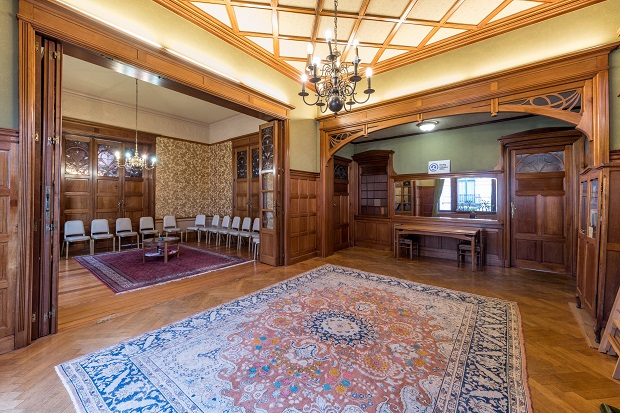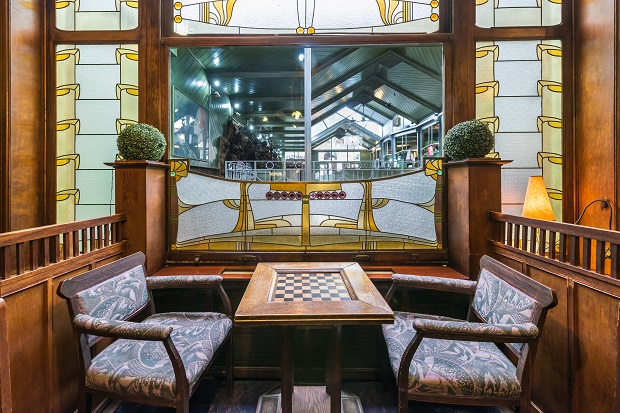- Daily & Weekly newsletters
- Buy & download The Bulletin
- Comment on our articles
Discover Brussels’ hidden Art Nouveau and Art Deco heritage at the Banad festival in March
More than 50 architectural treasures will open to the public over three successive weekends in March for the seventh edition of the Banad Festival.
Among the heritage buildings on display from 11 to 26 March, 15 sites are opening their doors for the first time. Once again it’s a unique opportunity to sneak a peek into interiors that are habitually off limits.
They include the Cuban embassy in Avenue Brugmann, the location for the press conference presenting the festival’s programme. The former home and studio of sculptor Fernand Dubois was designed by his friend and leading architect of the Art Nouveau movement across Europe, Victor Horta.

With its sober asymmetric lines and curvaceous fittings (pictured above), the listed building was an evocative setting for the preview of the festival. In addition to the interior visits and multilingual guided tours, highlights are a period object fair, themed evenings, intimate concerts and talks.
Organised by Explore. Brussels and other partners, the festival is one of the flagship projects for the region’s year of Art Nouveau. The occasion marks the 130th anniversary of the construction of Horta’s Tassel mansion, one of the pioneering architect’s earliest works.
“Brussels occupies a central place in terms of Art Nouveau and Art Deco," said the city’s alderwoman for culture Delphine Houba (PS). “And this heritage is located in the four corners of Brussels. Sometimes you don't even notice it, and Banad is there to remind us,” she added.

One of the new elements to the festival is a focus on women involved in the movements who have traditionally been overlooked, said Houba. She also welcomed the increased accessibility of the programme that includes visits in sign language and access for people with reduced mobility.
Each weekend of the festival is devoted to a geographical area of the capital to make it easier for visitors to combine trips to different places. A pass is available for multiple visits.
The first, 11 and 12 March, explores southern municipalities and boasts a large number of sites opening their doors to the public for the first time. Discover the astonishing Art Deco La Roue school in Anderlecht, the Art Nouveau Souverain school centre in Auderghem and Forest town hall, designed by the architect Dewin, who was inspired by the Flemish Renaissance style.
Other new locations are Villa Pelseneer, a cottage-style home in Avenue Churchill built for the son of Horta’s cabinetmaker, and the private home of Paul Aernaut (Avenue Minerve, Forest), with its marble bathroom and alcove bathtub. Meanwhile, the Collart-Van Gobbelschroy house is an Art Deco jewel in Woluwe- Saint-Pierre, graced by an entrance porch lined with pelicans.

If the weekend of 18 and 19 March contains fewer new architectural gems, it’s an opportunity to revisit some classics in the city-centre, Ixelles and northern suburbs. These include the Avenue Louise masterpieces, the Max Hallet and Solvay hotels, the Solvay library in Leopold park, as well as the former De Ruysscher paper mills (Rue de la Grande Île).
For the final weekend, 25 and 26 March, the festival heads to Schaerbeek, Saint-Josse, Etterbeek and Woluwe-Saint-Lambert. Newly-accessible sites are the Art Deco Homem de Macedo in Avenue Deschanel, the Art Nouveau Van Waesberghe house in Square Gutenberg, Quaker House (pictured above) in Square Ambiorix, and the much-anticipated Hôtel Van Eetvelde in Avenue Palmerston. For an immersion in Art Deco style, take a look at Maison Overloop in the Linthout quarter and Maison de Roy in Avenue Albert Jonnart.

The festival closes in Golden Age style with a cabaret evening celebrating the roaring twenties on 26 March. It’s hosted by the brasserie De Ultieme Hallucinatie in Saint-Josse (pictured above); the fabulous former Hôtel Cohn-Donnay has conserved many of its Art Nouveau features, from a geometric bow window to interior decoration that alludes to the Glasgow school and Viennese influences as well as Art Deco.
Photos: Hotel Solvay EB Photographe Voituron; Studio-home Fernand Dubois © Explore.Brussels, Ph Endre Sebok; Hélène De Rudder (née Du Menil) and Isidore De Rudder, Automne 1905 © Musée de la Ville de Bruxelles - Maison du Roi; Quaker House © Explore.Brussels - Ph Sophie Voituron; Hotel Cohn-Donnay © Explore.Brussels - Ph Sophie Voituron



















